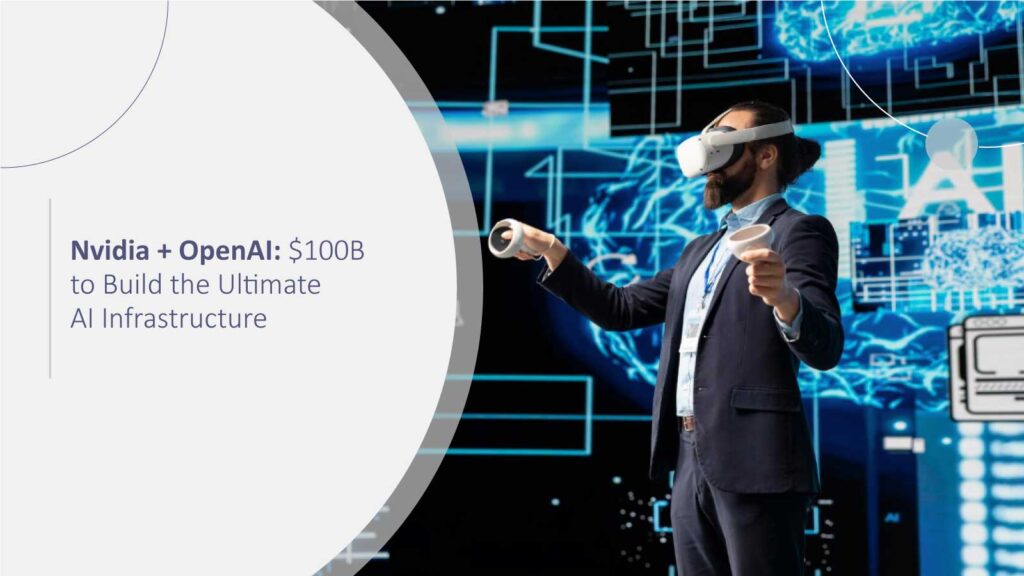It is interesting for the world to witness the future of intelligence being revamped by two tech powerhouses. NVIDIA and OpenAI have teamed up in what Jensen Huang describes as “the biggest AI infrastructure project in history,” a $100 billion pledge to construct multi-gigawatt, million-GPU AI factories that will power the entire world’s next generation of AI.
From Lab Breakthroughs to Real-World AI
The time of AI in the lab is completely gone. With OpenAI’s ChatGPT exceeding 700 million weekly active users, the need for more powerful and adaptable AI has never been greater. A McKinsey survey shows 78% of organizations now use AI in at least one business function, up from 55% a year earlier, highlighting how mainstream AI has become. OpenAI’s forthcoming models promise agentic reasoning, multimodal analysis, and massive context windows. Nevertheless, to achieve such a degree of differentiation, one thing is needed regardless: computational scale on a whole new level than before.
That is the point NVIDIA comes to their support. The NVIDIA graphics processing units (GPUs) have become the main support of the currently developed AI. So their collaboration is the key to the continued progress in the face of limitations in the hardware.
Imagine it as the process of creating the highways that the self-driving vehicles will later use. The AI revolution, without this infrastructure, would be like traffic jams in rush hours.
The Numbers Behind the Vision
OpenAI plans to install not less than 10 gigawatts worth of NVIDIA systems comprising the Vera Rubin Platform as the mainstay for its next-generation facilities, close to which the Vera Rubin Platform of NVIDIA is situated. Subsequently, according to Jensen Huang, NVIDIA will reinvest as much as $100 billion progressively for every new gigawatt that is switched on.
This is not an enhanced data center as such; it is a different class of AI hardware, an “AI factory.” The GPUs will be many and can be used in both training and inference of the AI models, which are the most advanced, thus leading to a reduction in the latency and providing the opportunity for real-time and reasoning-based applications to be made.
Sam Altman could not express it better: “It is the foundation of the whole infrastructure that we want to build, and the only source of energy we need to get better outcomes, create more revenue, and drive better models.”
Why Scale Matters
Back in 2016, when Jensen Huang made the first NVIDIA DGX handover to OpenAI, since then, the two teams have correspondingly levelled up their scale. OpenAI’s president, Greg Brockman, explains it as follows: “What we have now is a billion times the computational capability of that one server.” The cost that is associated with “one unit of intelligence” keeps lowering, though AI keeps growing in strength. This implies that more organizations, say in healthcare or education, can incorporate AI technologies without facing demand for resources that may exceed supply.
As Altman points out, otherwise, one would be required to pick between revolutionary applications: “Would we rather use AI for cancer research or for providing free education?” With huge capacity, we get to do both. McKinsey reports 65% of organizations are now regularly using generative AI in at least one business function, nearly double the 33% in 2023, showing how scale enables new applications.
Technology at the Core
It is designed to handle extremely complex tasks like agentic AI and multimodal reasoning. NVIDIA Vera Rubin is the architecture. These machines not only reduce the latency but also increase the efficiency of the models, which are very important as AI is becoming a part of workers’ daily routine, scientific research, and consumer applications.
In the latter part of 2026, the first gigawatt of NVIDIA systems is expected to start producing AI tokens that are operational, one of the very first achievements in the deployment of this worldwide infrastructure.
Human-Centered AI at Scale
One can easily be overwhelmed by the grandiose descriptions of the technical side of things, though the point of the partnership is, after all, to improve people’s lives. Just by rolling out the infrastructure, the range of possibilities is unfolding, from speeding up the process of the discovery of new drugs to making AI tutors accessible everywhere.
Jensen Huang underlines the objective: “We are actually going to link intelligence to every program, every scenario, every gadget, and it still is just the start.”
This is not only about faster GPUs for professionals and tech enthusiasts but also a whole new world of services and innovations, which opens with the help of this infrastructure. For example, think about the possibility of translating a language in real-time at the enterprise scale, or the use of predictive analytics for optimizing the supply chain, or even the processing of millions of medical images each day by AI that is empowered by this system simulation the only thing that makes all these potentialities achievable is this infrastructure.
The Future: From 10 GW to Infinity
The partnership is more of a roadmap that points the way to AI’s future rather than just an investment. NVIDIA and OpenAI have plans to extend their operations far beyond the initial 10 gigawatts; in fact, they are looking into building a network of AI factories spread worldwide. This model promises that AI will not only become more intelligent but also more accessible.
Businesses are given a simple message that the development of AI is the fastest road with the least resistance. The ones that will start using these instruments in their work now will be able to enjoy the competitive advantage granted to them by the wise use of AI in the future.
Key Takeaways for Readers
Scale without precedent: The NVIDIA and OpenAI collaboration is the most significant AI infrastructure deployment in history – multi-gigawatt, million-GPU “AI factories” type.
Infrastructure prepared for the future: Vera Rubin, the NVIDIA platform, acts as a base for advanced AI, which includes agentic reasoning and multimodal data processing.
More Intelligent but at a lower cost: The decrease in the cost per unit of intelligence enables more industries to deploy high-powered AI without having to compromise.
Positive Human Effects: The main point is to allow research, education, and application of enterprise at the same time, hence no forced trade-offs.
Long-Term View: This is only the initial stage. The installation will extend well beyond the preliminary 10 GW, thus creating a worldwide AI backbone.
Conclusion
They are not merely constructing servers, but the base of an AI-driven world is what NVIDIA and OpenAI are creating. The pathway the duo plans to take with a $100 billion bet is to move AI from isolated labs to every business, classroom, and device. The professionals and tech lovers have to say that this is a shift that happens once in a lifetime – the phase when AI is no longer just a tool but an essential utility just like electricity or the internet.
As Jensen Huang said, “Our journey is just starting.”
FAQs
1. What does the NVIDIA + OpenAI partnership mean?
This is a collaboration that is strategic in nature to create very large AI infrastructures with at least 10 gigawatts of NVIDIA GPU systems that will power OpenAI’s next-generation models.
2. How large is the investment?
NVIDIA will progressively commit up to $100 billion as each gigawatt of infrastructure goes into operation.
3. What is the main technology driving this project?
This is an installation on NVIDIA’s Vera Rubin platform that has been optimized to handle training and inference of agentic, reasoning, and multimodal AI.
4. What are the benefits of this initiative to businesses and professionals?
It will provide AI capabilities that can be scaled and are of high performance in any domain, from healthcare to the finance sector; hence, the latency will be reduced, and possibilities will increase.
5. When is the production going to start?
The first NVIDIA systems of one gigawatt are scheduled to start the production of operational AI tokens in the latter part of 2026.
For deeper insights on agentic AI governance, identity controls, and real‑world breach data, visit Cyber Tech Insights.
To participate in upcoming interviews, please reach out to our CyberTech Media Room at sudipto@intentamplify.com.


